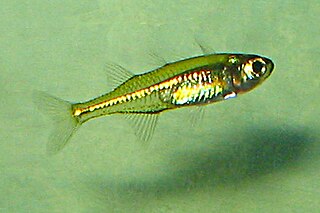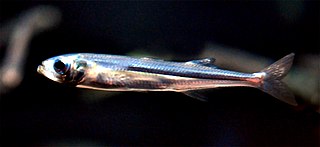
The threadfin rainbowfish or featherfin rainbowfish is a rainbowfish, the only species in the genus Iriatherina. It is characterized by long beautiful fins, and is among the most attractive of the rainbowfishes.

Rainbowfishes are small, colourful freshwater fishes belonging to the family Melanotaeniidae, found in northern and eastern Australia, New Guinea, Sulawesi and Madagascar.

The hardyhead silverside, also known as the broad-banded hardyhead, broad-banded silverside, Capricorn hardyhead, pitted hardyhead, robust hardyhead, robust silverside, slender hardyhead and wide-banded hardyhead silverside, is a silverside of the family Atherinidae. It occurs in the Indo-Pacific near the surface as well as in the Mediterranean, having invaded as a Lessepsian migrant through the Suez Canal.

The big-scale sand smelt is a species of fish in the family Atherinidae. It is a euryhaline amphidromous fish, up to 20 cm in length.

Atherina is a genus of fish of silverside family Atherinidae, found in the temperate and tropic zones. Up to 15 cm long, they are widespread in the Mediterranean, Black Sea, Sea of Azov in lagoons and estuaries. It comes to the low stream of the Dnieper, Southern Bug, Dniester and Danube Rivers.

Craterocephalus is a genus of small and slender brackish or freshwater silversides from Australia and New Guinea. It is the most diverse genus in the family Atherinidae, containing 25 of the 71 species.
The Dalhousie hardyhead is a species of silverside in the family Atherinidae. It is endemic to the warm waters of Dalhousie Springs in the Lake Eyre basin, Australia, along with the similar Craterocephalus gloveri. It inhabits shady areas in tropical freshwater streams at 20-39 °C, but has been recorded at 41.8 °C. Its food consists of gastropods, aquatic plants, green filamentous algae, detritus and small invertebrates; food is mainly taken from the substrate.
The Drysdale hardyhead is a species of fish in the family Atherinidae endemic to the Drysdale River in the Kimberley region of Australia. It is listed as near threatened on the IUCN Red List and rare under the Australian EPBC Act 1999. The specific name honours Ivantsoff's wife, Helena.
Craterocephalus lentiginosus, the freckled hardyhead is a species of fish in the family Atherinidae endemic to the Kimberley region in the northwest of Australia. It is also called the Prince Regent hardyhead.

The fly-specked hardyhead is a species of fish in the family Atherinidae endemic and widespread in the freshwater streams of the Northern Territory down the east coast of Queensland into southern Queensland. It forms shoals in streams' shallows. It grows up to 10 cm in length.

Alepidomus evermanni is a freshwater species of silverside endemic to western Cuba. This species grows to 3.3 cm (1.3 in) in standard length. It is the only known member of its genus. This species was described as Atherina evermanni by Carl H. Eigenmann in 1903 with a type locality of San Cristobal, Cuba. The specific name honours the American ichthyologist Barton Warren Evermann (1853-1932).
Bleheratherina pierucciae is a species of freshwater silverside endemic to New Caledonia. This species grows to 4.7 cm (1.9 in) in standard length. It is the only known species in its genus and subfamily. This species was described by Aarn and Walter Ivantsoff in 2009 with the type locality of the Tontouta River, New Caledonia,. The type was collected by Heiko Bleher and Paola Pierucci and Aarn and Ivantsoff named this species after both of them, the suffix -ae indicating Ms Pierucci's gender.

The Pacific blue-eye is a species of fish in the subfamily Pseudomugilinae native to eastern Australia. Described by Austrian naturalist Rudolf Kner in 1866, it comprises two subspecies that have been regarded as separate species in the past and may be once again with further study. It is a common fish of rivers and estuaries along the eastern seaboard from Cape York in North Queensland to southern New South Wales, the Burdekin Gap in central-north Queensland dividing the ranges of the two subspecies.
The panatela silverside is a species of reef-dwelling silverside from the subfamily Atherinomorinae which is found in the southwest Pacific Ocean. This species grows to 11 cm (4.3 in) in total length and is of minor importance to commercial fisheries. This species is the only species in the genus Stenatherina, although some authorities place it in the genus Hypoatherina. This species was described by David Starr Jordan and Robert Earl Richardson as Atherina panatela with the type locality given as Calayan Island in the Philippines. The specific name is the Spanish word for a long, thin cigar and is presumed to be a reference to the elongated, slender body of this fish.

Atherinoidei is a suborder of the order Atheriniformes comprising six families, with a mainly Old World distribution, although a few species are found in the western Atlantic Ocean.

Atherininae is a subfamily of silversides from the family, Atherinidae, the Old World silversides.
Atherinosoma elongata, the elongate hardyhead, is a species of silverside from the family Atherinidae. This species is found in shallow estuaries, sheltered bays, inlets, lagoons and estuaries in southwestern and southern Australia from the Bowes River in Western Australia to Nelson in southwestern Victoria with a gap which runs from Point Demspter in Western Australia and Fowlers Bay, South Australia. This species was described as Atherina elongata in 1879 by Carl Benjamin Klunzinger with a type locality of King George Sound in Western Australia.

Craterocephalinae is a subfamily of silversides from the family, Atherinidae, the Old World silversides. The majority of the species in this subfamily are freshwater fish, although some occur in brackish water. They are found in Australia and New Guinea.

Craterocephalus eyresii, the Lake Eyre hardyhead, is a species of freshwater silverside from the family Atherinidae which is endemic to the Lake Eyre basin in Australia.
Craterocephalus stramineus commonly called blackmast or strawman is a species of Actinopterygii fish that was described by Gilbert Percy Whitley in 1950. Craterocephalus stramineus belongs to the genus Craterocephalus, and family Atherinidae. It has no subspecies listed.











